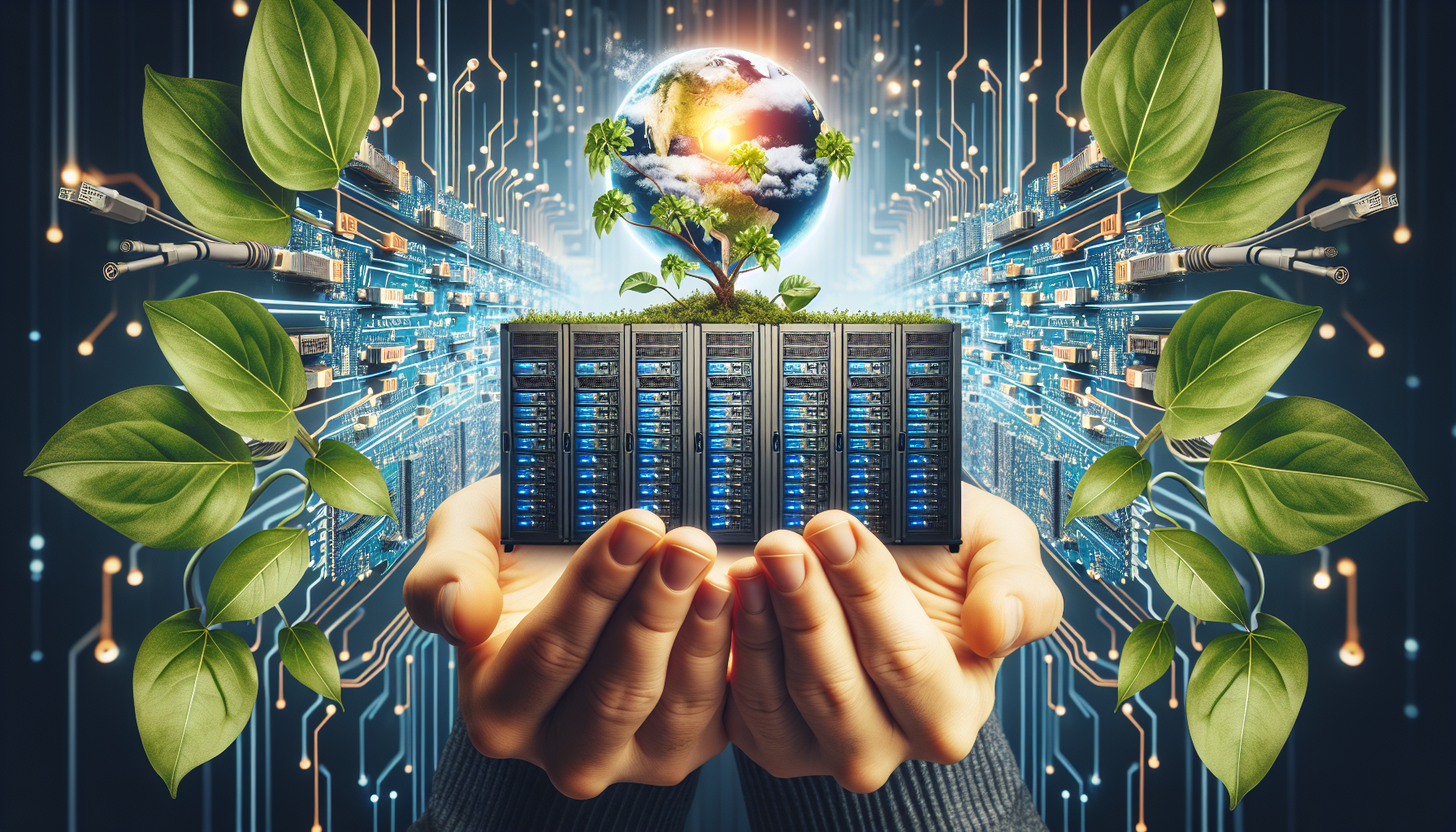18th June 2024
Top 10 Technology and sustainability ideas for the iT Sector

The intersection of technology and sustainability has emerged as a vital area of focus for the IT sector. As we continue to advance technologically, it becomes increasingly important for us to adopt practices that not only drive innovation but also ensure the preservation of our environment for future generations. The integration of sustainability into technological strategies is not just about reducing carbon footprints or minimising waste; it’s about creating a sustainable future that aligns with environmental, social, and governance (ESG) principles. This approach is crucial for businesses looking to thrive while making a positive impact on the planet.
Our discussion will delve into some of the most effective ideas and practices at the confluence of technology and sustainability in the IT sector. We’ll explore energy efficiency practices, highlighting how companies can reduce their energy consumption and costs. Waste reduction strategies will demonstrate the importance of minimising waste in IT operations, from hardware recycling to sustainable packaging. Sustainable software development will uncover the ways in which software design can contribute to sustainability goals. Additionally, we will look at eco-friendly office management, showcasing how everyday operations can be optimised for sustainability. Through this exploration, we aim to provide actionable insights for IT businesses committed to integrating ESG principles into their operations, ensuring a balance between technological advancement and environmental stewardship.
Energy Efficiency Practices
Data Centres and Energy Saving
Data centers, pivotal to modern IT infrastructure, consume substantial energy primarily due to cooling systems and server operations. We can significantly enhance energy efficiency by implementing advanced cooling technologies like liquid and free cooling, optimising airflow with hot and cold aisle containment, and utilising energy-efficient power distribution units and uninterruptible power supplies. Additionally, virtualisation and workload consolidation can drastically reduce the number of physical servers needed, further decreasing energy usage.
Renewable Energy Adoption
Adopting renewable energy sources is crucial for sustainable IT practices. By powering data centres with solar, wind, or hydroelectric power, we can reduce the carbon footprint and support global sustainability goals. Investments in renewable energy have surged, demonstrating a commitment to eco-friendly practices that not only preserve natural resources but also enhance our company’s reputation as a responsible corporate citizen.
Energy-efficient Hardware
Investing in hardware designed for energy efficiency, such as servers and storage devices with Energy Star certification, plays a vital role in reducing energy consumption. These technologies ensure that IT operations are not only more power-efficient but also cost-effective in the long run. By selecting equipment that meets high energy efficiency standards, we contribute to a more sustainable IT ecosystem and demonstrate our dedication to environmental stewardship.
Waste Reduction Strategies
In the realm of technology and sustainability, effective waste reduction strategies are pivotal. We are committed to addressing the growing concerns of e-waste through innovative practices.
Recycling and E-Waste Management
Our approach to sustainable e-waste management involves comprehensive recycling processes that not only protect the environment but also create economic opportunities. By encouraging the reuse of electronic devices, we extend their life spans and reduce the need for new products. This not only delays the manufacturing of new devices but also significantly cuts down on resource consumption and waste production. Our partnerships with professional recycling companies ensure that all e-waste is processed responsibly, protecting both the environment and our reputation.
Circular Computing
We pride ourselves on our Circular Remanufacturing Process, certified by BSI Kitemark, which transforms used laptops into products that perform like new. This rigorous process not only supports sustainability goals but also delivers quality and reliability at par with new devices. By choosing our remanufactured laptops, businesses contribute to a reduction in CO2 emissions, water usage, and mining of virgin materials, making a substantial positive impact on the environment.
Paperless Office Initiatives
Transitioning to a paperless office is another effective strategy we employ to reduce waste. By minimising the use of paper, we conserve natural resources and reduce our carbon footprint. Implementing digital solutions like cloud-based storage and e-signature software significantly decreases our reliance on paper, enhancing operational efficiency and security while supporting environmental sustainability.
Sustainable Software Development
Green Coding Practices
In our journey toward sustainable software development, we prioritise green coding practices which involve optimising code for reduced resource usage. This includes streamlining algorithms, minimising code complexity, and limiting resource consumption. By focusing on energy-efficient coding, we can significantly lower the environmental impact of our software solutions.
Optimising Cloud Resources
Effective cloud resource management is crucial for sustainability. We adopt strategies such as right-sizing cloud resources, optimising storage practices, and implementing server-less computing. These measures not only enhance energy efficiency but also reduce unnecessary energy and resource wastage, contributing to a more sustainable cloud environment.
AI and Machine Learning for Sustainability
Leveraging AI and machine learning, we aim to improve sustainability across various operations. Our initiatives include enhancing energy efficiency, optimising resource allocation, and reducing waste through intelligent automation and predictive analytics. AI-driven solutions enable us to monitor and adjust resource use in real-time, ensuring optimal environmental impact.
Eco-friendly Office Management
Implementing hybrid work schedules is a trans-formative approach in our efforts towards eco-friendly office management. By allowing employees to work from home, we significantly reduce the need for expansive office spaces, which are major contributors to energy consumption and greenhouse gas emissions. This model not only minimises commuting but also lessens the daily operational costs and environmental impact of maintaining large physical offices.
Eco-friendly Office Supplies
Transitioning to eco-friendly office supplies is crucial for reducing our environmental footprint. By opting for products made from recycled materials, such as biodegradable pens and organic printer paper, we not only conserve natural resources but also support the circular economy. Encouraging the use of these sustainable products among employees fosters a culture of environmental responsibility and can lead to significant reductions in waste.
Sustainable Infrastructure
Our commitment to sustainable infrastructure involves thoughtful planning and design that considers long-term environmental impacts. By integrating technologies that optimise energy use and selecting materials that are durable and recyclable, we create workspaces that are both efficient and environmentally friendly. This strategy extends to our digital infrastructure, where we prioritise cloud solutions that offer better energy efficiency compared to traditional data centres, further aligning our operations with our ESG goals.
Our Final Thoughts
Throughout this exploration of technology and sustainability within the IT sector, we have identified key practices and ideas that not only foster technological innovation but also ensure environmental stewardship. From energy efficiency and waste reduction strategies to sustainable software development and eco-friendly office management, the approaches outlined offer actionable insights for businesses aiming to integrate environmental, social, and governance (ESG) principles into their operations. These strategies highlight the industry’s capability to thrive while positively impacting the planet, demonstrating that sustainability and technological advancement can coexist harmoniously.
The significance of adopting these practices extends beyond mere compliance or cost-saving measures; it represents a commitment to a sustainable future where technology plays a pivotal role in solving some of the most critical environmental challenges. As we move forward, the IT sector stands at the forefront of this endeavour, poised to drive change through innovation. The collective effort and commitment to these sustainable practices are essential for catalysing broader societal changes, underscoring the importance of continuous exploration and integration of sustainability within the technological realm.

